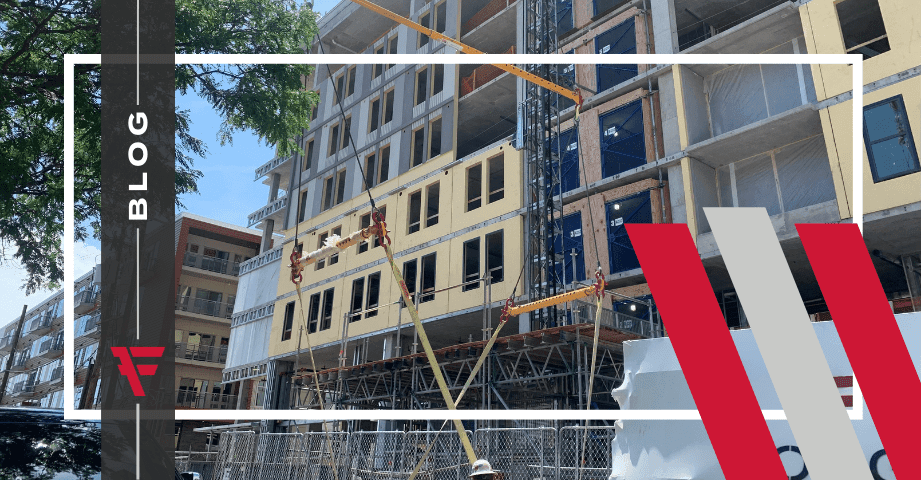Prefab wall panel manufacturers custom build panelized wall systems in an off-site fabrication shop using advanced machine technology and following specific standards. The prefab wall panels include exterior cladding (like wood, stone, stucco or other material), fenestration, water/air/vapor barrier control systems, flashing, insulation, and structural framing. After transporting the prefabricated walling systems to the job site, workers simply lift and install the prefabricated panels according to the architect’s plans.
Four Benefits of Panelized Wall Construction
Utilizing prefab exterior walls, like Sto’s prefabrication solution, Sto Panel® Technology, can reduce construction costs, contribute to sustainability, accelerate building enclosure schedules, improve quality control, lessen onsite labor needs, and enhance job site safety. The success of a project depends tremendously on early planning for the use of prefabricated building techniques, and good communication between the architect, GC and panel manufacturer.
- Pre Engineered Wall Panels Lessen Construction Costs
Prefab wall panels manufacturers help accelerate project delivery time, reducing overall construction costs and allowing you to realize profits sooner:
-
- Efficient prefabricated exterior wall panel construction generates less waste, to save on materials.
- Because much of prefab wall construction occurs in a factory, you can also lower your security costs by lessening the risk of theft and vandalism on the project site.
- Prefab construction lessens construction time over traditional methods by offering efficient upfront planning, minimized delays due to on-site weather factors, reduced subcontractor scheduling delays, and the ability to manufacture the panels while the initial sitework and structural framing of the building is being completed. In fact, it can take less than half the time to complete modular construction compared to traditional building methods, which can reduce project costs tremendously.
- Prefabricated wall panels for commercial construction significantly reduces the number of skilled labor installers required on the job site, which is particularly beneficial, as many contractors today struggle with ongoing skilled labor shortages.
- Sustainable Panelized Wall System Manufacturers
Prefabricated wall panels can contribute significantly to sustainability:
-
- Building prefab walls inside a manufacturing facility can cut raw material waste at the job site by nearly 50 percent compared to traditional construction. A survey of 800 building professionals by McGraw-Hill Construction found that 77 percent reported a decrease in construction site waste due to modular construction.
- Prefab panel manufacturing allows for the in-house recycling of materials.
- The controlled environment of a prefabricated factory allows for more precise construction, tighter joints, and proper storage of materials which improves the overall quality and performance of the wall system.
- Factory-built construction of structural wall panels significantly lessens truck traffic, equipment, and material suppliers around the job site, to minimize soil disturbance and erosion of the area.
- Panel Wall Construction Improves Quality Control
Manufacturing of prefabricated construction boards occurs in a climate controlled, indoor environment by an experienced crew and precise machine equipment, to ensure uniform quality between the sub-assemblies of the structure and conformity to building code. Traditional site-built structures depend on independent contractors’ varying schedules and skill levels, which can affect the craftsmanship and overall quality of the finished product.
Moreover, fabricators can work out flaws in the prefab walls in the factory setting before any product reaches the job site.
- Prefabricated Panels Create a Safe Work Environment
Using prefabricated panels can improve the safety of workers and future occupants of the building:
-
- The ergonomic design of indoor construction facilities improves the safety and comfort of the workers.
- The controlled environment also provides more efficient access to tools and improved lighting.
- Prefabricated wall panels come assembled and ready to drop into place with the help of a crane, to avoid the hazards of using scaffolds and other methods to build a multi-floor wall on-site.
- Building walls off-site will reduce workers’ exposure to dangerous wind, rain, lightning, as well as changing ground conditions.
- In addition, factory-controlled environments utilize dry materials, lessening the risk for problems associated with moisture, environmental hazards, and dirt, which protects workers on the construction site, along with the project’s future occupants.



